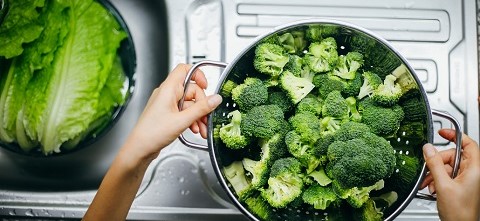
Nothing brings flavor or texture to a dish like a good cooking oil.
These added oils can enhance lubrication and crispiness, as well as improving mouthfeel and absorption of fat-soluble nutrients.
But it’s not just about type of oil. Your storage methods and cooking methods—and the amount of oil used—can all affect the health benefits.
Even the food manufacturer’s processing methods will shape the nutritional value.
Oil processes and storage
Cooking oils receive grades based on extraction method.
Processors extract unrefined extra virgin oils by physical methods, such as pressing or heating without chemicals. This prevents nutrient loss.
Cold-pressed oil extraction is similar, but it’s performed at lower temperatures to prevent oil damage and nutrient loss.
Crushing seeds at high temperatures—then treating with chemicals and deodorizers to remove any off flavors—produces refined oils. If it doesn’t say “virgin” or “extra virgin” on the label, an oil is likely refined.
Expeller-pressed options don’t use chemical extractives, but they do apply heat, bleaching agents and deodorizers during processing. This method generates a greater yield with a higher smoke point and lower cost, but it also destroys many of the beneficial nutrients. Excess heat during processing can make oil oxidize and go rancid.
When storing oils at home, remember that heat, light and air are the enemies of oil. Store cooking oil in a sealed, dark glass or in a stainless steel container. Then place it in a cool, dark location—not above the stove.
Let’s break down some of the most popular cooking oils.
Olive oil
Extra virgin olive oil can have a fruity, bitter and pungent flavor. Avoid oils with a rancid, vinegar or metallic taste.
Extra virgin olive oil can help reduce the risk of developing heart disease, Parkinson’s disease and Alzheimer’s disease. It may also help reduce the risk of breast cancer and colorectal cancers, as well as improving blood sugar levels.
Olive oil’s monounsaturated oleic acid and high polyphenol content—that latter giving it a peppery, bitter flavor—deliver the health benefits.
Look for extra virgin options packed in dark glass, with a harvest date within the past 15 months. The color of the oil does not determine quality. Buy only the amount you will use within eight to ten weeks.
Olive oil can be swapped for other vegetable oils in cooking and baking.
Some people may worry about burning the oil at higher temperatures, but the higher polyphenols in the virgin options prevent this from happening. You can cook with olive oil at higher temperatures.
For extra virgin olive oil, the typical smoke point—the temperature at which it smokes or burns—is 383 F.
That said, heat depletes many of the beneficial polyphenols. To preserve them, use a lower temperature when cooking, or simply add the oil later in the cooking process.
You can also add olive oil to your dish after you’re done cooking. Many people prefer to drizzle it on a salad or another dish as a dressing.
Refined olive oils won’t have high polyphenol benefits, but they do provide a higher smoke point and a milder flavor.
Avocado oil
Extracted from avocado pulp, this oil boasts a pleasant mushroom-like flavor with a buttery, herbaceous aroma. (You should avoid oils that smell rancid or stale.)
Avocado oil has heart-healthy monounsaturated and polyunsaturated oils, such as oleic acid. It also provides beta-sitosterol, which may help with cholesterol levels and prostate health, and it contains lutein for eye health. Used topically, it can provide vitamin E for skin health.
The smoke point is higher for the extra virgin options, with a range of 375-400 F. Use it for sauteing, grilling, roasting or in salad dressings.
Keep in mind that avocado oil is more expensive than other oils. It should be green in color and a bit cloudy for the least-refined option. The refined oil appears more yellow and clear.
Buy only what you will use within a few months, because avocado oil oxidizes with heat and, with air exposure, it will spoil. Be sure to look at the oil’s production date, too, because you’ll want the freshest version available.
Canola oil
Canola oil comes from a genetically modified plant called rapeseed. It has a neutral flavor.
This oil is high in monounsaturated fats, as well as polyunsaturated omega-3s. When swapped for saturated fat in the diet, canola oil can help reduce LDL cholesterol—the bad kind—and help lower your risk of heart disease.
With a smoke point of 460 F, you can use canola oil to bake, saute, grill or make salad dressings. And while it is less expensive, it is also a highly refined oil.
Coconut oil
Unrefined coconut oil—virgin, cold-pressed—adds a distinct coconut flavor. Refined versions have a more neutral flavor.
Virgin cold-pressed coconut oil contains high levels of medium chain triglycerides, a saturated fat. Refined coconut oils have even higher levels of medium chain triglycerides.
Research on medium chain triglycerides shows promise in treating Alzheimer’s disease and epilepsy. It may also aid in weight loss and fat malabsorption—but the jury is still out on that.
Given its high saturated fat content, experts hold concern that it may raise LDL cholesterol and increase the risk of heart disease.
The smoke point of coconut oil is 350 F, so it’s best used for baking or cooking under this temperature. It solidifies when cool or at room temperature. Swap it for butter in recipes to change the flavor, or make it dairy-free or plant-based.
Virgin coconut oil options provide the strongest coconut flavor at the lowest smoke point. For higher cooking temperatures or a more neutral flavor, look for a refined version.
Corn, soybean and vegetable oil
Vegetable oil is a mix of plant oils—usually soy, corn or canola, which are often genetically modified. The refining process gives these oils a versatile, neutral flavor.
Corn, soybean and vegetable oils have a similar fat profile: high in monounsaturated fat and low in saturated fats.
Similar to canola oil, where saturated fats are replaced with unsaturated fats, the risk of heart disease decreases with corn, soybean and vegetable oil. Given the refining process and high omega-6 fats in these oils, however, they can cause inflammation.
Soybean oil tends to have the highest vitamin content; corn oil the lowest.
With a higher smoke point of 460 F, these types of oils can be used for frying and baking. The low cost and versatility makes them a common choice for processed-food products and fast-food fryers.
Dietitian’s choice
For the healthiest approach to cooking, limit your use of products that contain corn oil, soybean oil or vegetable oil. Choose extra virgin olive oil as your primary oil.
 /a>
/a>
 /a>
/a>
 /a>
/a>
Very interesting and I have always wonder about the different oils.